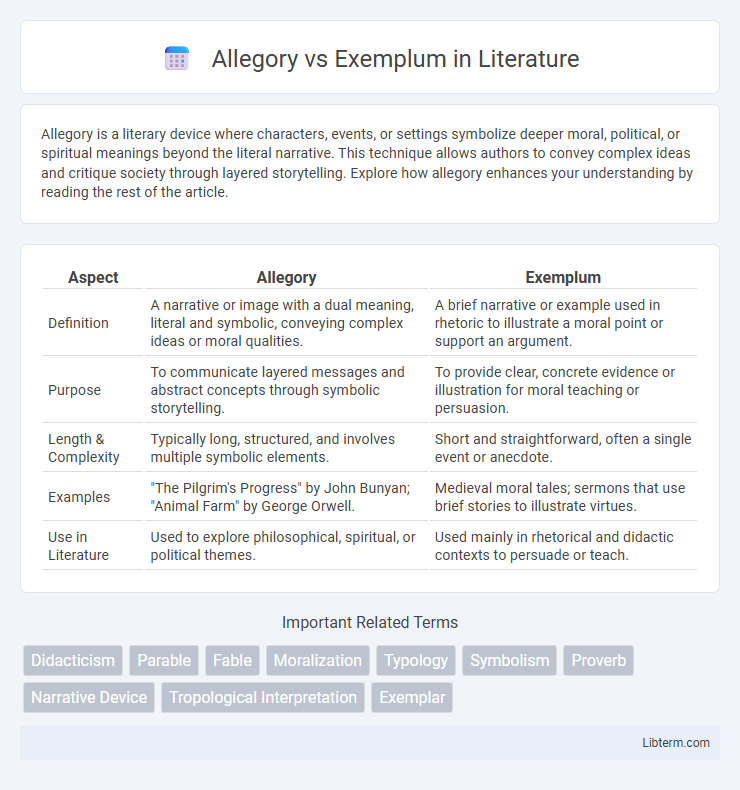Allegory is a literary device where characters, events, or settings symbolize deeper moral, political, or spiritual meanings beyond the literal narrative. This technique allows authors to convey complex ideas and critique society through layered storytelling. Explore how allegory enhances your understanding by reading the rest of the article.
Table of Comparison
| Aspect | Allegory | Exemplum |
|---|---|---|
| Definition | A narrative or image with a dual meaning, literal and symbolic, conveying complex ideas or moral qualities. | A brief narrative or example used in rhetoric to illustrate a moral point or support an argument. |
| Purpose | To communicate layered messages and abstract concepts through symbolic storytelling. | To provide clear, concrete evidence or illustration for moral teaching or persuasion. |
| Length & Complexity | Typically long, structured, and involves multiple symbolic elements. | Short and straightforward, often a single event or anecdote. |
| Examples | "The Pilgrim's Progress" by John Bunyan; "Animal Farm" by George Orwell. | Medieval moral tales; sermons that use brief stories to illustrate virtues. |
| Use in Literature | Used to explore philosophical, spiritual, or political themes. | Used mainly in rhetorical and didactic contexts to persuade or teach. |
Introduction to Allegory and Exemplum
Allegory is a narrative technique in which characters, events, and settings symbolically represent abstract ideas or moral qualities, creating a layered meaning beyond the literal story. Exemplum refers to a brief moral anecdote or example used primarily in medieval literature to illustrate a practical lesson or ethical principle. Both forms function as didactic tools, with allegories providing complex, extended symbolic frameworks and exempla offering concise, instructive illustrations.
Defining Allegory: Meaning and Features
Allegory is a narrative technique in which characters, events, and settings symbolize abstract ideas or moral qualities, creating a layered meaning beyond the literal story. It often features a consistent system of symbols that work together to convey complex themes such as good versus evil, spiritual redemption, or social critique. Unlike exemplum, which provides a straightforward moral lesson through a brief anecdote, allegory offers a sustained, multifaceted exploration of philosophical or ethical concepts.
What is Exemplum? Characteristics Explained
Exemplum is a rhetorical device used to illustrate a moral point or principle through a short narrative or example, often drawn from history, literature, or folklore. It features clear, concise storytelling with a specific ethical lesson intended to persuade or instruct the audience. Unlike allegory, which employs extended symbolic representation, exemplum delivers straightforward illustrations that emphasize a practical or instructive message.
Historical Origins of Allegory and Exemplum
Allegory and exemplum both have roots in classical rhetoric and medieval literature, with allegory emerging prominently in ancient Greek philosophy and biblical texts as a method to convey layered meanings through symbolic characters and narratives. Exemplum originated in medieval sermon literature, particularly within Christian homiletics, where it served as a moral example or illustrative anecdote to support ethical teachings. The historical development of allegory spans works like Plato's dialogues and Augustine's writings, while exempla became standardized through collections such as Jacques de Vitry's sermons, embedding them deeply in didactic traditions.
Key Differences: Allegory vs Exemplum
Allegory represents an extended narrative where characters, events, and settings symbolically convey complex abstract ideas or moral qualities throughout the entire story. Exemplum is a brief, illustrative anecdote or example used within rhetoric or sermons to highlight a specific moral lesson or principle. The key difference lies in Allegory's broad symbolic storytelling versus Exemplum's concise, targeted illustrative purpose.
Use of Allegory in Literature and Art
Allegory in literature and art functions as a symbolic narrative where characters, events, and settings represent abstract ideas, enabling creators to convey complex moral, political, or spiritual messages. This technique allows artists and authors to explore themes such as good versus evil, human virtues, or societal critiques through layered interpretations that engage audiences on multiple levels. Unlike exemplum, which provides a straightforward didactic example, allegory encourages deeper reflection by embedding meaning within a compelling and often metaphorical story structure.
Role of Exemplum in Storytelling and Teaching
The role of exemplum in storytelling and teaching is to provide concrete examples or moral lessons that clarify abstract ideas or virtues, making them easier to understand and remember. Unlike allegory, which conveys meaning through symbolic narratives involving multiple interconnected elements, exempla are brief, focused anecdotes or stories used to illustrate a single point or ethical principle. In medieval literature and rhetoric, exempla were crucial tools for preachers and educators to engage audiences and reinforce doctrinal messages through relatable, real-life scenarios.
Famous Examples of Allegories
Famous examples of allegories include George Orwell's "Animal Farm," which uses farm animals to represent the Russian Revolution, and John Bunyan's "The Pilgrim's Progress," portraying a spiritual journey through symbolic characters and events. Plato's "Allegory of the Cave" illustrates the difference between perception and reality through prisoners trapped in a cave. Unlike exempla, which are brief moral anecdotes, allegories typically convey complex, extended metaphors with multiple layers of meaning.
Notable Exemplum in Classic Texts
Notable exempla in classic texts, such as the Pardoner's Tale in Chaucer's *The Canterbury Tales*, vividly illustrate moral lessons through concise, relatable stories. Exempla serve as practical examples within sermons or literary works, guiding ethical behavior by demonstrating consequences of vice or virtue. Unlike allegories that use extended symbolic narratives, exempla provide direct, impactful anecdotes to reinforce doctrinal teachings and rhetorical persuasion.
How to Choose Between Allegory and Exemplum in Writing
When deciding between allegory and exemplum in writing, consider the complexity of the message and the desired clarity. Allegory suits works intending layered symbolism and abstract themes, while exemplum works best for direct, moral lessons through concrete examples. Selecting the appropriate device hinges on the writer's goal to either evoke reflection or straightforward guidance.
Allegory Infographic

 libterm.com
libterm.com